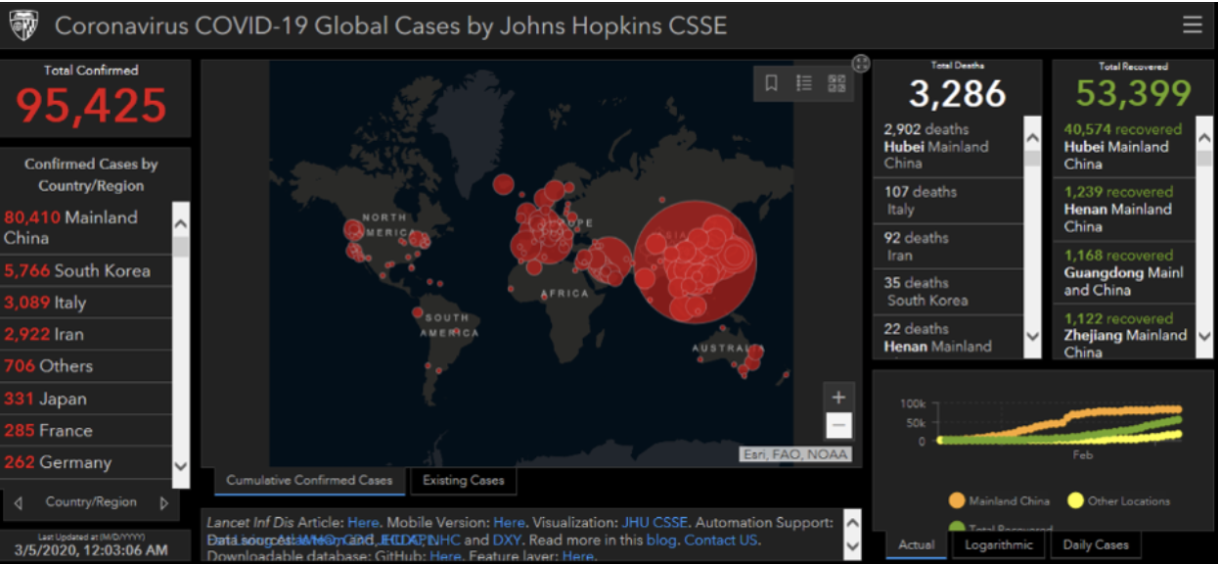SLK Blog
Un-Spam Your Life: Tips & Tools For a Healthy Digital Life

Photo by Domenico Loia on Unsplash
In recent weeks Google has seen more than 18 million daily malware and phishing emails related to COVID-19.
Spam is annoying and dangerous. It’s also everywhere. With the current coronavirus crisis, cybercriminals are hard at work with securing domains and emails to take advantage of people’s fear and need for information. There has been a significant increase in both potentially malicious websites and scam emails being sent through the web. Emails like CDC-Covid19@cdc[.]gov. look like highly credible sources, but only lead to hackers taking advantage of your lack of knowledge. Hackers may even create content that you think is real, and while you are visiting their site, they have full access to your information. You may have seen the Coronavirus map below and might have thought of it as credible. Beware, because while you are viewing the map hackers are downloading malware onto your computer.

Reason Labs
It is important for you to know how to navigate safely online, and most importantly how to recognize spam emails being sent to you so you can be protected from potentially damaging situations. When navigating the web make sure you access only websites from credible and reputable sources. When in doubt, let your cautious judgment take over. If you are looking for information, there are always credible sources. When you receive an email, always verify the information. If a quick search comes out empty, chances are, the topic and email sent to you are fake.
While you cannot get rid of scam emails and spam completely, there are tricks and tools you can use to make your mailbox more efficient:
1. Train your mailbox
The easy mindless thing to do when you see spam in your mailbox is to delete it. Resist the urge. DO NOT DELETE IT. Report the email as spam and have your mailbox learn from this action so that in the future it can learn to detect spam more effectively.
Go a step further and also teach your mailbox what ISN’T spam. Go through your spam folder to make sure everything is filtered correctly both ways. This helps your mailbox learn, and also assures you don’t miss any important emails. Even with most email providers now dividing messages into various folders, they still need human help to learn and adapt so that they can do their job more efficiently and keep you working optimally.
2. Do not respond to spam
If you believe that an email is spam DO NOT open it. Place it directly in the spam or junk folder. If you are in doubt, you can open the email and read through it. If it is spam close it again WITHOUT CLICKING ON ANY LINKS, and mark it as spam. It is important not to interact with spam as you never know what the spam sender has put in the email (virus, malware, etc.).
If you have clicked on a link and later realized that the sender is spam, email your contact list and make them aware that the specific sender is sending spam messages, and you have inadvertently opened one of their spam emails. It’s important to warn your contacts because the spam sender may have accessed your contact list information when you clicked on links they put in the email they sent you. This puts your contacts at risk of becoming spamming victims themselves.
Here is a little anecdote to keep your mind sharp concerning spam:
An acquaintance once opened a spam email by accident and deleted it after they realized it was spam. They didn’t warn their contacts, whom all received an email “from them” which was in reality from the spammer, asking for a sum of money for investment. The person’s father received the email, and as a business person used to diversified investments, he started to get a wire transfer ready. Because of doubt with the sum, the person’s father called them to ask a question about the investment, which is where they realized the email was sent by a spammer and were saved from losing money. Had the person’s father not called them, a very real possibility, the spammer would have gotten away with it. Do not risk a loss of any kind, if you think the email you opened is spam, warn your contacts. The last thing you want is to harm them in any way.

Photo by Mathilde LMD on Unsplash
3. Keep an eye out for spoofs
Recently the World Health Organisation (WHO) sent out an email from “
4. Keep your email address as private as you can
In today’s digital world where businesses and websites ask for your email address to sign up to newsletters, receive discounts etc. it has become increasingly hard to keep emails private. What many users do is keep a separate email for sharing online and another email that is used for more sensitive information.
5. Change your email
If you are receiving too many spam emails, there probably isn’t a good solution for you at this point. You can start using the old email as the email to sign up for different things online, especially for websites with low-security settings. Make sure to migrate all the accounts that have sensitive information to your new email that way your old email contains no risk of a spammer or hacker getting their hands on your private information.
6. Make sure your anti-virus is running
Protect your online space and your computer data by using strong anti-virus protection when browsing online and opening email attachments.
Here are the anti-virus programs we suggest: Bitdefender, TrendMicro, Kaspersky, AVG, Norton and McAfee
Remaining vigilant and thoughtful about online navigation and emails is a must in today’s tech-savvy world. Going the extra mile with your security can save you significantly in both money and headaches. So be smart. If you need any advice/help, you know who to call.

